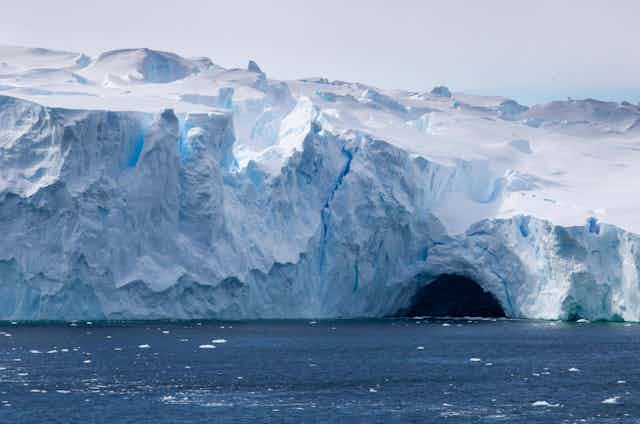Scott Morrison on Tuesday will announce $804.4 million over a decade to strengthen Australia’s strategic and scientific capabilities in the Antarctic.
The funding, including for drones, helicopters and vehicles, will enable Australia’s to penetrate inland areas of its claimed territory of East Antartica previously unreachable.
In strategic terms, Australia has had a watchful eye on China’s increasing involvement in recent years in the Antarctic and in Antarctic politics.
The money includes $136.6 million for inland travel capability, mapping, mobile stations, environmental protection, and other core activities.
Another $109 million will fund drone fleets and vehicles to map “inaccessible and fragile areas of East Antartica”, establishing an “Antarctic Eye” with integrated censors and cameras feeding real-time information back.
It will also purchase four new medium-lift helicopters with a range of 550 kilometres when launched from the RSV Nuyina that will give access to areas which have been beyond reach. Helicopters provide more landing flexibility than fixed-wing aircraft.
The Nuyina was launched late last year, when it was described by the government as “the most advanced polar research vessel in the world”.
Other funds in the package will go into shipping support, marine science (including a new krill aquarium in Hobart), environment management including cleaning up “legacy waste”, research on Antarctic ice sheet science to improve understanding of climate change, and international engagement.
Morrison said the Antarctic investment would support jobs in Australia – with Australian businesses, contractors, medical suppliers and other providers benefiting.
Foreign Minister Marise Payne said the government’s proposed investments “are a clear marker of our enduring commitment to the Antarctic Treaty system, its scientific foundations, and Australia’s leadership within it”.
Environment Minister Sussan Ley said: “When I sit down with world leaders to discuss the Antarctic and the Southern Ocean in the face of increasing pressures, the strategic importance of our scientific leadership is clear.
"We need to ensure that the Antarctic remains a place of science and conservation, one that is free from conflict and which is protected from exploitation.”
Australia was a founding member of the Antarctic Treaty, signed by the Menzies government in 1959.
Seven countries have made territorial claims in Antarctica. Apart from Australia, the others are Argentina, Chile, France, New Zealand, Norway, and the United Kingdom.
Other countries including China, India, Italy, Pakistan, Russia, Ukraine, and the United States have stations there.
Australia’s claimed territory covers 42% of the continent and includes the vast majority of East Antarctica.
Under the Hawke government Australia together with France led the successful push to have an international agreement reached to prevent mining in the Antarctic.
Ley has been pushing for the expansion of marine protected areas but getting consensus is hard, with China and Russia being difficult.
Last year the government abandoned a proposal to build a 2700 metre concrete runway at Australia’s Davis research station, following a detailed environmental and economic assessment.
Ley said then that “higher projected costs, potential environmental impacts, and the complexity of a 20-year construction process in an extreme and sensitive environment, are such that we will now focus on alternative options for expanding our wider Antarctic Program capability”.
Commenting on the government announcement, Elizabeth Buchanan, lecturer in strategic studies at Deakin University, told The Conversation the promised investment in drone capability - an ‘Antarctic Eye’ network – was “sorely needed”, and a “solid solution to Australia’s inland traverse challenges”.
“However, this clearly signals Canberra’s move into the grey zone of dual-use technologies - a space in which Russia and China are well versed,” Buchanan said.
But she said “all these new capabilities and technological investments still beg the question - so what? Should Australia find evidence of non-compliance, what does this mean? We can’t enforce or punish in the context of Antarctica, just tar a state’s reputation.
"I am not sure this is enough to make any real impact on long-term Antarctic posturing from states like China.”
Buchanan said it was disappointing to see limited multilateral planning in the government’s new investment program.
“Asset-sharing, such as vessels and aviation infrastructure with like-minded parties or developing Antarctic elements to groupings like the QUAD, or AUKUS, is surely worth consideration. This would be smart policy for the long term.”
“Russian and Chinese Antarctic activity might present challenges, however Australia is both curtailed and restrained by responding or this activity in any substantial way due to a fear of eroding or weakening the Antarctic Treaty System (ATS) status quo. It is the ATS which protects and supports the Australian Antarctic Territory.
"Smart Australian policy would be to lead compliance and oversight mechanisms such as inspections or constant aerial surveillance as tabled by Canberra’s new ‘Antarctic Eye’ program – call out and shine light on transgressions.
"But keep in mind the ATS is without enforcement mechanisms, and Russia and China have ‘veto’ rights to stymie real governance progress if necessary.”

